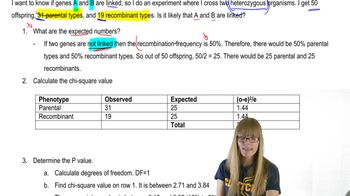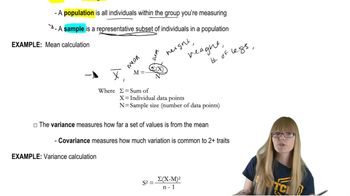When designed matings cannot be conducted in an organism (for example, in humans), how do we learn that genes are linked, and how do we map them?
Table of contents
- 1. Introduction to Genetics51m
- 2. Mendel's Laws of Inheritance3h 37m
- 3. Extensions to Mendelian Inheritance2h 41m
- 4. Genetic Mapping and Linkage2h 28m
- 5. Genetics of Bacteria and Viruses1h 21m
- 6. Chromosomal Variation1h 48m
- 7. DNA and Chromosome Structure56m
- 8. DNA Replication1h 10m
- 9. Mitosis and Meiosis1h 34m
- 10. Transcription1h 0m
- 11. Translation58m
- 12. Gene Regulation in Prokaryotes1h 19m
- 13. Gene Regulation in Eukaryotes44m
- 14. Genetic Control of Development44m
- 15. Genomes and Genomics1h 50m
- 16. Transposable Elements47m
- 17. Mutation, Repair, and Recombination1h 6m
- 18. Molecular Genetic Tools19m
- 19. Cancer Genetics29m
- 20. Quantitative Genetics1h 26m
- 21. Population Genetics50m
- 22. Evolutionary Genetics29m
4. Genetic Mapping and Linkage
Mapping Overview
Problem 1a
Textbook Question
How was it established experimentally that the frequency of recombination (crossing over) between two genes is related to the distance between them along the chromosome?
 Verified step by step guidance
Verified step by step guidance1
Understand the concept: Recombination frequency between two genes is the proportion of offspring in which a crossover event has occurred between those genes during meiosis. This frequency is used as a measure of the physical distance between genes on a chromosome.
Set up a genetic cross: Researchers performed controlled crosses between organisms heterozygous for two linked genes. By analyzing the phenotypes of the offspring, they could identify recombinant and parental types based on the combination of traits inherited.
Calculate recombination frequency: The recombination frequency (RF) is calculated using the formula: \(\text{RF} = \frac{\text{Number of recombinant offspring}}{\text{Total number of offspring}} \times 100\%\). This gives the percentage of recombinant progeny, reflecting crossover events between the two genes.
Compare recombination frequencies for different gene pairs: By repeating these crosses for multiple pairs of genes located at various positions on the chromosome, researchers observed that gene pairs physically closer together had lower recombination frequencies, while those farther apart had higher frequencies.
Conclude the relationship: The consistent correlation between recombination frequency and physical distance led to the conclusion that recombination frequency is proportional to the distance between genes on a chromosome, forming the basis for genetic linkage maps.
 Verified video answer for a similar problem:
Verified video answer for a similar problem:This video solution was recommended by our tutors as helpful for the problem above
Video duration:
2mPlay a video:
Was this helpful?
Key Concepts
Here are the essential concepts you must grasp in order to answer the question correctly.
Genetic Recombination and Crossing Over
Genetic recombination occurs during meiosis when homologous chromosomes exchange segments, resulting in new allele combinations. Crossing over is the physical process that facilitates this exchange, and its frequency reflects how often two genes are separated during this event.
Recommended video:
Guided course

Discovery of Crossing Over
Linkage and Genetic Mapping
Genes located close together on the same chromosome tend to be inherited together, a phenomenon called linkage. By measuring recombination frequencies between gene pairs, scientists can estimate their relative distances, creating genetic maps that represent gene order and spacing.
Recommended video:
Guided course

Chi Square and Linkage
Experimental Measurement of Recombination Frequency
Recombination frequency is experimentally determined by crossing organisms with known genotypes and analyzing offspring phenotypes. The proportion of recombinant offspring indicates how often crossing over occurs between two genes, allowing researchers to correlate recombination rates with physical gene distances.
Recommended video:
Guided course

Mathematical Measurements
Related Videos
Related Practice
Textbook Question
424
views


